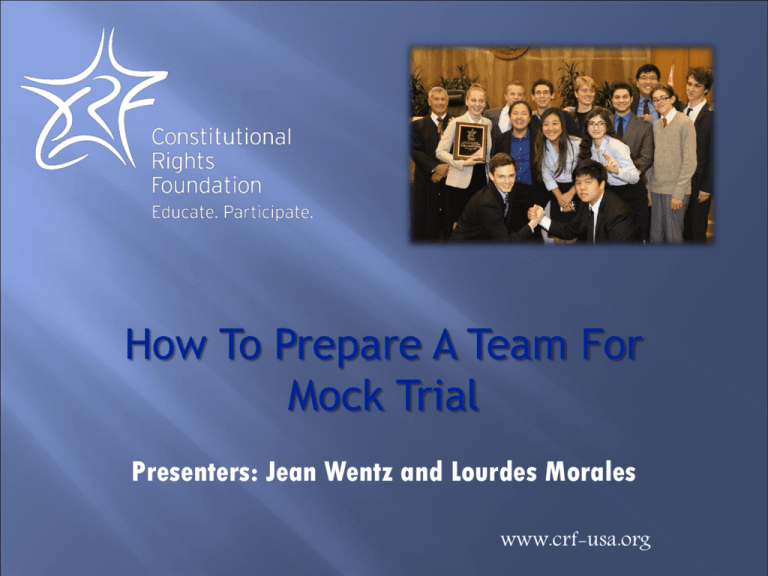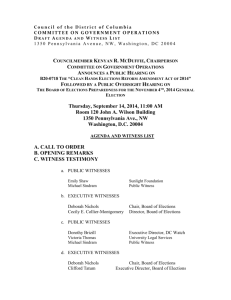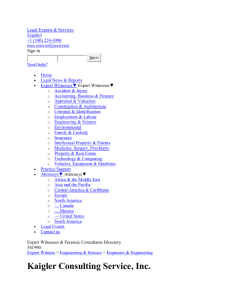the PowerPoint Presentation
advertisement

How To Prepare A Team For Mock Trial Presenters: Jean Wentz and Lourdes Morales www.crf-usa.org A team must have at least 8, but no more than 25 members Some counties allow schools to field more than 1 team www.crf-usa.org Secure Your Coaches Teacher Coaches Attorney Coaches Read the Entire Case Packet Fact situation Charges against the Defendant Exhibits Stipulations Witness Statements The Simplified Rules of Evidence Pretrial materials Team Rulebook (separate document) Criminal versus Civil Trial Bench versus Jury Trial Prosecution versus Defense Lay Witness versus Expert Witness Presumption of Innocence Burden of Proof Reasonable Doubt Direct versus Circumstantial Evidence Break down Elements of each Charge Outline the evidence for and against the charge—Look for: Forensic evidence Eyewitness testimony Statements by the defendant Motive or lack of motive Opportunity, or lack of opportunity, to commit the crime Corroboration or Inconsistencies between witnesses Decide what witness will testify to this evidence Remember: The pretrial ruling may impact what evidence is available Pretrial Attorneys For students who are analytical and can “spar” with a judge Trial Attorneys Decide who will direct/cross each witness, witness, who will open/close Balance is important Witnesses Witness roles are gender neutral Court Clerk Long attention span and math skills important Bailiff Commanding presence Unofficial Timekeeper (Optional) Suggestion: Allow other students to “shadow” those with roles Purpose is to establish facts to prove or disprove the case, explore weaknesses in your opponent’s case Scope of Directs: Limited to information in the witness’s statement or the fact situation/stipulations if witness would reasonably know that information • Exception: expert witnesses Write Direct Examinations— Time Constraints 14 minutes total (including re-directs) Cut “extraneous” and “objectionable” information Refer back to outline of the case to focus testimony Important: Allow sufficient time for Re-directs Approaching exhibits Just a Guideline: • Directs should be between 2 minutes and 4 minutes • 12 minutes for 4 directs; 1 minute for any redirects; 1 minute buffer DON’T RUN OUT OF TIME! Create likeable, credible, interesting witnesses who speak slowly Over-the-top versus “realistic” witnesses But remember: No accents or costumes! Avoid Objectionable Testimony: No leading questions Witness should be responsive to the question asked No long narratives Provide foundation for testimony Avoid improper hearsay, opinion and character testimony Purpose is to explore weaknesses in opponent’s case, test witness’s credibility and establish facts supporting the crossexaminer’s case Scope of Crosses: Crosses must call for answers based on information in the witness’s own statement Mock trial crosses are not limited to issues raised during direct 10 minutes total, or an average of 2 ½ minutes each Typically, ask between 10 and 25 questions Typically, the cross of the defendant is the longest Allow extra time for non-responsive witnesses, and for expert witnesses who have leeway to explain answers Use leading questions designed to get a yes or no answer Make 3 or 4 points and sit down! The purpose of redirects is to clarify or explain bad or confusing cross testimony Suggestion: Write 3 or 4 re-direct questions for possible Remember: Redirects are limited in scope to what is use during the trial raised on cross examination Typically 3 to 4 minutes long The opening is a short, concise statement of the case, not an argument! Use terms like— The evidence will show You will hear You will learn You will find ____ witness will testify Prosecution Opening Structure: Explain what you intend to prove and how you will prove it Present events in an orderly sequence Suggest motive, describe opportunity Tell your story! Defense Opening Structure: Remember—You do not have the burden of proof! The purpose is to explain the weaknesses in the prosecution’s case, and why there will be reasonable doubt Mention the name of each witness you will be calling and provide some insight (even if very brief) into what that witness will be testifying about Use a Theme. Examples: Prosecution: • This case is about a defendant who couldn’t control his anger • The defendant’s greed got the better of him • This case is about a defendant who is pretending to be insane to avoid taking responsibility for his own actions Defense: • The case is based on witnesses who could not see, and an investigator who did not look • This case is about mistaken identity • This case is about a student who acted out of self-defense Typically, closings are 5 1/2 to 6 minutes long (depending on the Opening) Unlike the opening, the closing is an argument! Prosecution Closing: The Prosecution has the burden of proof Walk through the charges and explain proof • Be specific! • Explain motive and opportunity Defense Closing: No burden of proof! Walk through the charges and explain reasonable doubt Be specific! If applicable, discuss other reasonable suspects Be flexible! Adjust argument based on the evidence 1 minute for each The purpose is to respond to your opponent’s closing arguments Scoring Tips: Don’t go in cold! Practice beforehand Don’t run out of time! High School Only Review fundamental concepts: What is stare decisis? What rulings trump others? What is a holding? What is dicta? How is the Constitution applicable to this case? What is the role of the Judge and pretrialer in the pretrial argument? Read the cases Important: Don’t go beyond the abbreviated cases The holdings and facts may have been changed deliberately Analyze the cases For each case, identify the holding and facts in support Determine which side the holding helps and hurts If good for your side, you may want to use that case to support your argument If bad for your side, you will need to distinguish the case based on its facts Write your Pretrial Argument Keep in mind time constraints 4 minutes for Opening 2 minutes for Rebuttal Create Opening Argument citing 3 to 4 cases that support it Start with an introduction, state your argument, then cite case law, then conclude Rebuttal: Don’t go in cold! Anticipate the main arguments on the other side Listen to what the other side says and only counter what the other side said Practice ending rebuttal before time is called The key to pretrial is practice! Avoid repeating your arguments 1. 2. 3. 4. 5. 6. 7. 8. Understand courtroom and the order of trial Analyze the case, develop theories and themes Write and practice directs Practice cross examinations on witnesses Review the Rules of the Competition Practice introductions Research expert opinions Monitor and review any errata issued in the case 1. 2. 3. 4. 5. 6. 7. 8. 9. Review the Rules of Evidence. Review the Witness Statements and your Direct and Cross Examinations and then: Determine what is objectionable Practice how to respond to any objections to your exams, and how to make objections to the other side’s exams. Review the Rules of the Competition Learn when to make rule violation objections Practice how to respond to rule violation objections Develop Cross examinations Learn how to Impeach Witnesses Learn how to control Witnesses Learn how to enter Exhibits Create Opening and Closing statements Draft Preliminary Matters Develop “character” for direct examination Prepare for Cross Know your statement! Know what you cannot say (what is objectionable) Remember: Running the other team’s time is not allowed Optional but can be Helpful Benefits of Scrimmaging— Increase understanding of mock trial competition Learn strengths and weaknesses of your case Fun opportunity to meet other teams! Check out CRF website for list of teams





